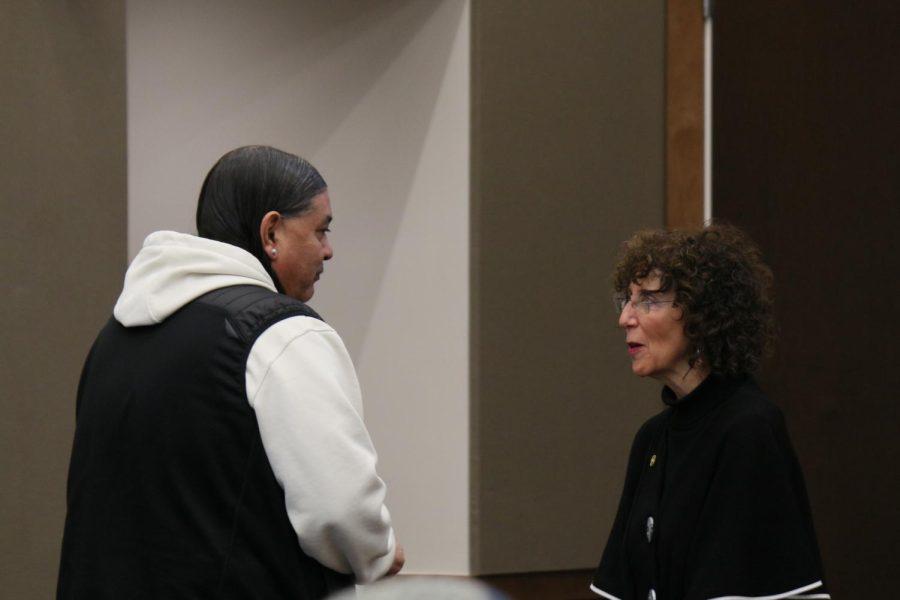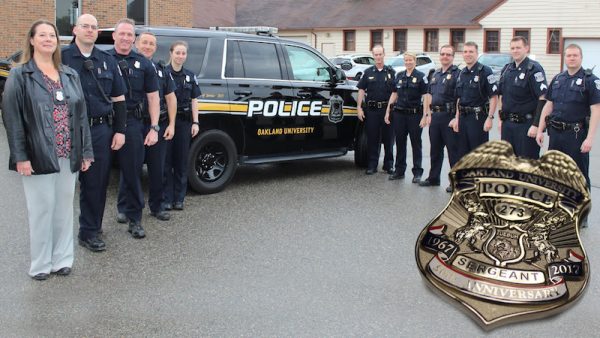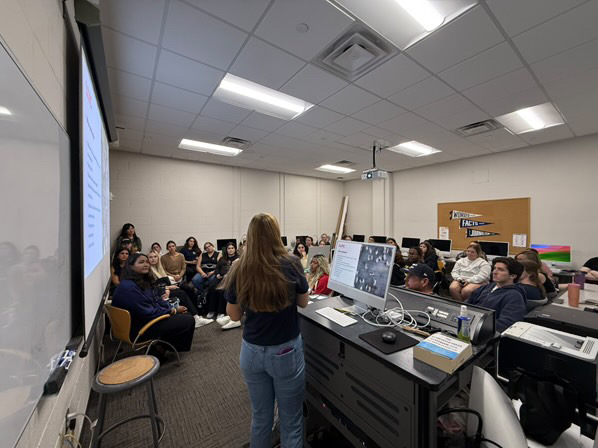LAS plaque reveal ceremony affirms OU’s commitment to Indigenous community
President Pescovitz speaking with Indigenous community member Wayne Cleland at last Friday’s Land Acknowledgement Statement plaque reveal ceremony.
Last Friday’s Land Acknowledgement Statement (LAS) plaque reveal ceremony featured a slate of speakers including the people behind OU’s LAS and individuals from the broader Indigenous community. The event also outlined plans for the display of two new plaques etched with the statement, as well as a newly-designated Anishinaabe historical site on campus.
OU’s LAS, which was crafted over the span of three years by Professor Megan Peiser (Choctaw Nation of Oklahoma), English major Ashleigh Dubie (Cherokee), Professor Andrea Knutson and Professor Mozhgon Rajaee with the help of Indigenous leaders in the area, was approved by the University Senate in Feb. 2021 and formally announced to the campus community in May 2021.
Two plaques etched with the entirety of OU’s LAS will be installed on campus as visible displays for the campus community, with one plaque going in Kresge Library and the other in the Oakland Center. The statement is featured completely in italics below.
“Oakland University resides on the ancestral, traditional, and contemporary lands of the Anishinaabe, known as the Three Fires Confederacy, comprised of the Ojibwe, Odawa, and Potawatomi. The land was ceded in the 1807 Treaty of Detroit and makes up southeast Michigan.
In recognizing the history and respecting the sovereignty of Michigan’s Indian Nations, Oakland University honors the heritage of Indigenous communities and their significant role in shaping the course of this region. Further, we recognize the wrongs done to those forcibly removed from their Homelands and commit to fostering an environment of inclusion that is responsive to the needs of First Peoples through our words, policies, and actions.
The preservation and perpetuation of customs and traditions of Indigenous nations are essential to our shared cultural heritage. A deep understanding of Native peoples’ past and present informs the teaching, research, and community engagement of the university in its ongoing effort to elevate the dignity of all people and serve as shared stewards of the land.”
The event began with people occupying the ballroom while musician Joe Reilly (Cherokee) played his acoustic guitar and sang. President Ora Hirsch Pescovitz then took the stage to formally begin the ceremony. Her speech thanked those responsible for creating OU’s LAS, while also affirming the university’s long-term commitment to Indigenous peoples.
“The words that are etched in this plaque at Oakland University are by no means simply words,” Pescovitz said. “The statement is just one step, but it cannot be our only step. The statement cannot be seen as our attempt to just check a box when it comes to diversity, equity and inclusion. It must be backed up by our continued journey to advance diversity and tolerance at Oakland. Quite simply, our acknowledgment statement must be a representation of our values. The statement references the past, but the statement must reflect our actions in the present and our commitment to honoring and acknowledging native peoples who have been historically marginalized, from American institutions, from politics, and from academia. Making a college education more accessible to Native communities is part of showing our commitment. Our goals must include supporting more Native American students in their higher educational journey, and recruiting and retaining Native Americans.”
Perhaps the most newsworthy part of Pescovitz’s speech was her announcement of a newly designated historical site on campus.
“I’d like to announce the designation of an Anishinaabe historical site for Oakland University,” Pescovitz said. “The parcel of land is located on South Campus near Library Drive south of Pioneer Drive. We are so excited about this and honored that we can now designate this site and look forward to an ongoing friendship.”
Knutson took the stage after Pescovitz. In her speech she urged supporters of OU’s LAS to donate to The National Native American Boarding School Healing Coalition — an organization dedicated to undoing the harm boarding schools inflicted on Indigenous peoples.
Knutson went on to thank those involved in crafting OU’s LAS, specifically highlighting the work of OU students Tara Maudrie (Sault Sainte Marie tribe of Chippewa Indians) and Dubie, and encouraging future students to help continue the important work of building this community on campus.
“This work that we’ve done over the last few years could not have been done without the leadership of Native American students on this campus,” Knutson said. “ … We would like to invite our Native American students on this campus into leadership positions as we move forward with this work.”
Knutson then introduced Dubie, who took her time on stage to reflect on her work crafting OU’s LAS, what it means to leave a legacy and how she can contribute to a better future for her community.
“Rather than thinking about what I will do to have me remembered, I want to think about what I will do that will help my community,” Dubie said. “I was taught to always think seven generations beyond me, to think about those that will come after me. This land acknowledgement and the work I do in education has those generations at the forefront of my mind.”
Dubie proceeded to read the entirety of OU’s LAS before introducing Peiser, who was unable to attend the ceremony and presented her speech in a pre-recorded video. She too spoke about this acknowledgement statement being an important step in OU’s commitment to Indigenous peoples.
“I’m so grateful for all of the hands who have lent themselves to this essential first step, and speaking the truth about the history of land theft, and genocide, the places here on plan today,” Peiser said. “ … This land acknowledgement is a seed to put on our mouths and in our hearts and minds. It does not absolve past wrongs inflicted brutally upon Indigenous peoples – it does not reconcile us to the original people of this land. Rather, it is a promise to move forward with the responsibility of being good relatives to this land.”
Vice President for Academic Affairs and Provost Britt Rios-Ellis then took the stage, sharing a few words on the importance of OU’s LAS before introducing the next Native American speaker Eric Hemenway (Anishinaabe). He spoke about his extensive history working to preserve the history and culture of Indigenous peoples in Michigan.
Hemenway shared a creation myth about people being created in the Great Lakes and spoke to the importance of our relationship to the land here, before sharing a harrowing story about his experience reclaiming some of his ancestors and performing a burial ceremony.
“It was really, really emotional … It was as if the whole village was coming alive,” Hemenway said. “ … It was our duty as Anishinaabe people in the present day to take care of our ancestors.”
Rios-Ellis then retook the stage to introduce the final speakers of the ceremony, Indigenous community members Wayne Cleland and his father Jerry Cleland. Both men were also prominently featured during last fall’s OU Peace Day Concert.
Wayne Cleland spoke on the harm boarding schools inflicted on Indigenous peoples and how OU’s LAS is important for Indigenous people to be able to connect with their communities while receiving their education.
“In my dad’s situation, he didn’t get back to his community till he was 30 or 35 years old,” Wayne Cleland said. “ … So with this land acknowledgement here at this school, that’s a good thing for all the students who may come here who might be in the same situation my dad was raised in.”
The ceremony then concluded with Jerry Cleland performing a song of prayer and a blessing. He thanked young Indigenous people for continuing to push for change, and urged us all to do better for our fellow man during these difficult times and act as better stewards of the land going forward.






